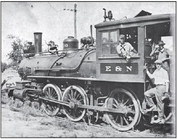Ill-fated railroad started by small town grit


Travelers driving along U.S. Highway 53 through Ettrick are greeted by a welcome sign adorned with a majestic eagle that reads, “Welcome to Ettrick — Life, Liberty and the Pur...


Travelers driving along U.S. Highway 53 through Ettrick are greeted by a welcome sign adorned with a majestic eagle that reads, “Welcome to Ettrick — Life, Liberty and the Pur...